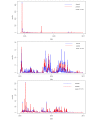Evaluation of Different Recruitment Methods: Longitudinal, Web-Based, Pan-European Physical Activity Through Sustainable Transport Approaches (PASTA) Project
- PMID: 31066715
- PMCID: PMC6533046
- DOI: 10.2196/11492
Evaluation of Different Recruitment Methods: Longitudinal, Web-Based, Pan-European Physical Activity Through Sustainable Transport Approaches (PASTA) Project
Abstract
Background: Sufficient sample size and minimal sample bias are core requirements for empirical data analyses. Combining opportunistic recruitment with a Web-based survey and data-collection platform yields new benefits over traditional recruitment approaches.
Objective: This paper aims to report the success of different recruitment methods and obtain data on participants' characteristics, participation behavior, recruitment rates, and representativeness of the sample.
Methods: A longitudinal, Web-based survey was implemented as part of the European PASTA (Physical Activity through Sustainable Transport Approaches) project, between November 2014 and December 2016. During this period, participants were recruited from 7 European cities on a rolling basis. A standardized guide on recruitment strategy was developed for all cities, to reach a sufficient number of adult participants. To make use of the strengths and minimize weakness, a combination of different opportunistic recruitment methods was applied. In addition, the random sampling approach was applied in the city of Örebro. To reduce the attrition rate and improve real-time monitoring, the Web-based platform featured a participant's and a researchers' user interface and dashboard.
Results: Overall, 10,691 participants were recruited; most people found out about the survey through their workplace or employer (2300/10691, 21.51%), outreach promotion (2219/10691, 20.76%), and social media (1859/10691, 17.39%). The average number of questionnaires filled in per participant varied significantly between the cities (P<.001), with the highest number in Zurich (11.0, SE 0.33) and the lowest in Örebro (4.8, SE 0.17). Collaboration with local organizations, the use of Facebook and mailing lists, and direct street recruitment were the most effective approaches in reaching a high share of participants (P<.001). Considering the invested working hours, Facebook was one of the most time-efficient methods. Compared with the cities' census data, the composition of study participants was broadly representative in terms of gender distribution; however, the study included younger and better-educated participants.
Conclusions: We observed that offering a mixed recruitment approach was highly effective in achieving a high participation rate. The highest attrition rate and the lowest average number of questionnaires filled in per participant were observed in Örebro, which also recruited participants through random sampling. These findings suggest that people who are more interested in the topic are more willing to participate and stay in a survey than those who are selected randomly and may not have a strong connection to the research topic. Although direct face-to-face contacts were very effective with respect to the number of recruited participants, recruiting people through social media was not only effective but also very time efficient. The collected data are based on one of the largest recruited longitudinal samples with a common recruitment strategy in different European cities.
Keywords: Web-based questionnaire; Web-based survey; longitudinal survey; mobile phone; multicentral; opportunistic sampling; recruitment.
©Mailin Gaupp-Berghausen, Elisabeth Raser, Esther Anaya-Boig, Ione Avila-Palencia, Audrey de Nazelle, Evi Dons, Helen Franzen, Regine Gerike, Thomas Götschi, Francesco Iacorossi, Reinhard Hössinger, Mark Nieuwenhuijsen, David Rojas-Rueda, Julian Sanchez, Emilia Smeds, Manja Deforth, Arnout Standaert, Erik Stigell, Tom Cole-Hunter, Luc Int Panis. Originally published in the Journal of Medical Internet Research (http://www.jmir.org), 09.03.2019.
Conflict of interest statement
Conflicts of Interest: None declared.
Figures




References
-
- Fekete C, Segerer W, Gemperli A, Brinkhof MW, SwiSCI Study Group Participation rates, response bias and response behaviours in the community survey of the Swiss Spinal Cord Injury Cohort Study (SwiSCI) BMC Med Res Methodol. 2015 Oct 08;15:80. doi: 10.1186/s12874-015-0076-0. https://bmcmedresmethodol.biomedcentral.com/articles/10.1186/s12874-015-... 10.1186/s12874-015-0076-0 - DOI - DOI - PMC - PubMed
-
- Mishra GD, Hockey R, Powers J, Loxton D, Tooth L, Rowlands I, Byles J, Dobson A. Recruitment via the Internet and social networking sites: the 1989-1995 cohort of the Australian Longitudinal Study on Women's Health. J Med Internet Res. 2014 Dec 15;16(12):e279. doi: 10.2196/jmir.3788. http://www.jmir.org/2014/12/e279/ v16i12e279 - DOI - PMC - PubMed

